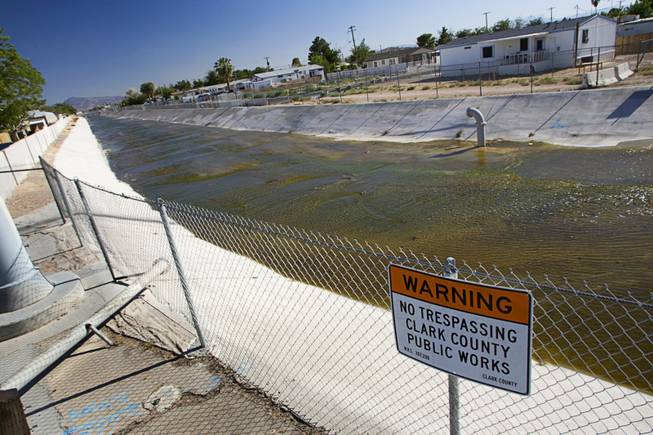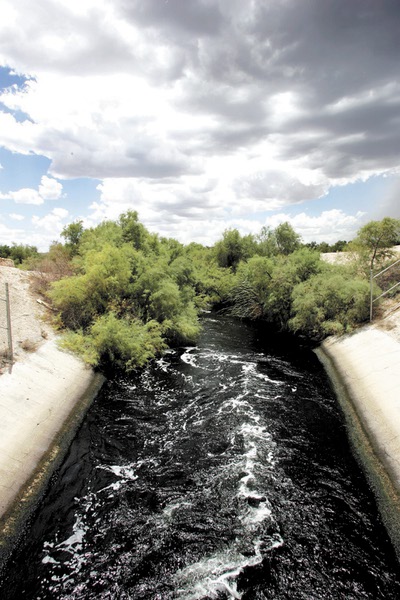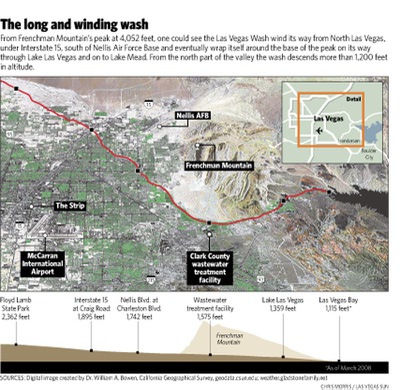
Treated wastewater from the North Las Vegas Water Reclamation Facility flows down the Sloan channel near Toiyabe Street and East Carey Avenue on Thursday, June 23, 2011, in Las Vegas.
Sunday, Aug. 24, 2014 | 2 a.m.
Most of us don’t think about what happens when we flush the toilet. But the same water that swirls in the bowl, after being treated, ends up in our taps. It’s a disgusting thought, but the system helps fill Lake Mead and quench Las Vegas’ thirst.
Every day, about 100 million gallons of raw sewage is treated by the Clark County Water Reclamation District, which cleans sewage water for unincorporated Southern Nevada. This district has seven facilities and serves rural communities as well as a vast swath of the valley, including the Strip.
Roughly 90 million gallons of reclaimed water is released daily into the Las Vegas Wash, replenishing Lake Mead with billions of gallons every year. In exchange, we are allowed to take that much more water out of the lake, over and above our preset allotment.
Other treatment plants in the valley also reclaim water, but the bulk of the effort starts at the corner of Hollywood Boulevard and the appropriately named Sludgemore Avenue. It’s the site of the Flamingo Water Resource Center, a Disneyland-sized facility on the eastern edge of the valley and Nevada’s largest wastewater treatment plant.
There, in a six-hour process involving biology and technology, sewage is purified of pollutants and made ready to be put back into Lake Mead, where it will be stored and pumped back out for final treatment before entering our faucets.
1. Sewers
Everything that’s flushed from homes and businesses ends up in the reclamation district’s 2,000-mile sewer pipe network that delivers contents to nearby treatment facilities. Most of the journey is sloped downhill, with occasional “lift stations” that pump the sewage up to higher pipes, where gravity again takes over.
2. Pre-treatment sifting
At this point, the sewage looks more like dirty water than the brown sludge we see in cartoons and movies. Referred to as influent, incoming sewage passes through screens that trap trash. A mechanical rake removes the trash, which is dried and taken to the Apex Landfill.
3. Primary treatment
The raw sewage flows into large underground tanks, where heavy solids settle and form sludge, while scum — primarily grease and oil — floats to the top. Rotating metal arms skim surface scum into troughs that are vacuumed out weekly and scrape bottom sludge into hoppers that lead to underground pits, where it is pumped out and dried in a later process.
4. Aeration
Activated sludge, a slurry of recycled liquid with a large number of living organisms, is blended into the wastewater. The microorganisms feed on organic contaminants in the wastewater and help remove phosphorus that can damage the environment and hurt wildlife. Compressed air is injected into the water to supply the oxygen needed to convert ammonia from urine into nitrogen gas, which dissipates into the atmosphere.
5. Secondary treatment
The wastewater is piped into large tanks, where the remaining activated sludge sinks to the bottom. Half of the sludge is pumped back to be used again, while the other half is mixed with polymer and sludge from primary treatment. That mixture is dried in centrifuges to form sludge cakes — dark, crumbly substances that landfills use to decompose trash faster.
6. Filtration
The water is filtered through sand and anthracite to remove tiny solids and most of the remaining phosphorus, which fuels destructive algae blooms that can poison and kill wildlife in lakes.
7. Disinfection
Because viruses and bacteria still may lurk in the wastewater, it is run through an underground chamber where ultraviolet lamps neutralize any remaining pathogens by rearranging their DNA and preventing them from multiplying. This allows wastewater workers to clean the water without having to introduce chemicals such as chlorine.
8. Effluent
Considered fully treated and ready for reuse, most of the reclaimed water, called effluent, is released into the Las Vegas Wash. A portion is diverted to Wetlands Park, golf courses, parks and businesses. Along the 10-mile journey to Lake Mead, water from the Flamingo center mixes with water from treatment plants operated by Las Vegas, North Las Vegas and Henderson.
9. Back to the tap
The Southern Nevada Water Authority pulls the water out of Lake Mead to serve the valley’s 2 million residents and 40 million annual visitors. Water officials further treat the water — as they do run-off and other piped-in water — to bring it to safe-drinking standards.



Join the Discussion:
Check this out for a full explanation of our conversion to the LiveFyre commenting system and instructions on how to sign up for an account.
Full comments policy